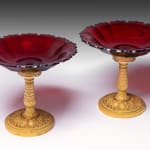Pair of Russian Ruby Glass and Ormolu Tazze
IMPERIAL GLASSWORKS, ST. PETERSBURG, RUSSIA, CIRCA 1825
22.5 x 25.5 cm
8 ¾ x 10 in
8 ¾ x 10 in
635a
Further images
Each with a circular ruby glass bowl with a shaped edge, on a cast, chased ormolu base with a band of roses above a band of four-petal flowerheads, the stem...
Each with a circular ruby glass bowl with a shaped edge, on a cast, chased ormolu base with a band of roses above a band of four-petal flowerheads, the stem with foliate decoration and anthemion, the circular base with anthemion, scrolling decoration with flowerheads and grapes.
The St Petersburg Glassworks is first documented in 1738; it was renamed the Imperial Glassworks in 1792. From the late eighteenth century, it was the leading glass factory in Russia and during the first half of the nineteenth century was noted for its cut glass, painted glass and a wide range of coloured glass.
As well as independent bronze founders in the St. Petersburg area, the Imperial Glassworks had a bronze workshop and the first three decades of the 19th century saw the productions of items of glassware mounted with chased, gilded bronze.
According to Asharina, coloured glass reappeared in items produced in Russia's glassworks by the late 1820s (N.A. Asharina, Russian glass of the 17th-20th centuries, Corning, N.Y., 1990, p. 46). Gold was used in the glassmaking process to produce the red colour, and it was known as 'gold ruby'.
This renewed desire for colour is evident from accounts of the 1828-29 manufacturers' exhibit: ‘Objects of colored crystal glass, although previously out of fashion, are once again highly prized. They appear as though made of sapphire, emerald, topaz, ruby, or other precious stone.’ (A Description of the First Public Exhibition of Russian Manufactures in St. Petersburg in 1828-29', St. Petersburg, 1829, p. 209)
An oval glass footed bowl dating from the first third of the 19th century which belonged to Emperor Nicolas I is a fine example of the collaborative achievements of the glass and bronze makers at this time and has similar bronze floral ornament and a shaped edge to the ruby glass bowl as this pair of tazze.
A comparable pair of ormolu and purple cut-glass tazze, 17cm high, sold at Christie’s London, 6 December 2007 for £16,100 (lot 193).
The St Petersburg Glassworks is first documented in 1738; it was renamed the Imperial Glassworks in 1792. From the late eighteenth century, it was the leading glass factory in Russia and during the first half of the nineteenth century was noted for its cut glass, painted glass and a wide range of coloured glass.
As well as independent bronze founders in the St. Petersburg area, the Imperial Glassworks had a bronze workshop and the first three decades of the 19th century saw the productions of items of glassware mounted with chased, gilded bronze.
According to Asharina, coloured glass reappeared in items produced in Russia's glassworks by the late 1820s (N.A. Asharina, Russian glass of the 17th-20th centuries, Corning, N.Y., 1990, p. 46). Gold was used in the glassmaking process to produce the red colour, and it was known as 'gold ruby'.
This renewed desire for colour is evident from accounts of the 1828-29 manufacturers' exhibit: ‘Objects of colored crystal glass, although previously out of fashion, are once again highly prized. They appear as though made of sapphire, emerald, topaz, ruby, or other precious stone.’ (A Description of the First Public Exhibition of Russian Manufactures in St. Petersburg in 1828-29', St. Petersburg, 1829, p. 209)
An oval glass footed bowl dating from the first third of the 19th century which belonged to Emperor Nicolas I is a fine example of the collaborative achievements of the glass and bronze makers at this time and has similar bronze floral ornament and a shaped edge to the ruby glass bowl as this pair of tazze.
A comparable pair of ormolu and purple cut-glass tazze, 17cm high, sold at Christie’s London, 6 December 2007 for £16,100 (lot 193).






